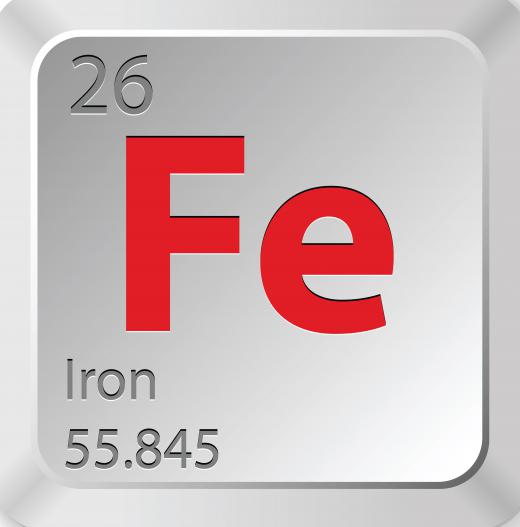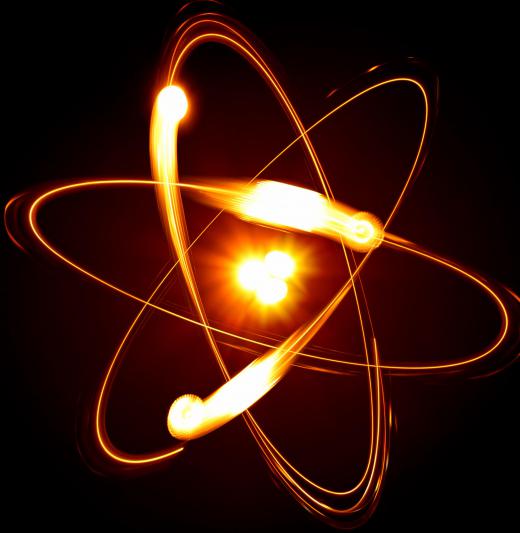What is Atomic Weight?
 Mary McMahon
Mary McMahon
Atomic weight is the weight of atoms of an element. The science behind this measurement is extremely complex, and it has changed quite a bit since the early 1800s, when the concept was first proposed. It is also important to distinguish between weight and mass: atomic weight, also called relative atomic mass, reflects the average weight of a single atom of an element, while atomic mass refers to the weight of a specific atom.
Simple textbooks and science courses often describe atomic weight as the number of protons and neutrons in an element added together. An element with two protons and two neutrons, for example, would be considered to have a weight of four under this system. Unfortunately, neutrons actually weigh more than protons, which makes this rough guideline a bit inaccurate.

Individual atoms are extremely small, and rather challenging to weigh on their own. Early researchers arrived at a system that involved determining the weight of an element relative to the weight of another. Several benchmark elements were proposed, including hydrogen, with the current measurements being derived from carbon-12, a stable and abundant form of carbon. An atomic mass unit, the unit of measurement used to arrive at atomic weight, consists of 1/12 the weight of carbon-12.

There's another complexity to add to the equation, which is that most elements exist in the form of multiple isotopes, each of which has a slightly different mass. Measurements of relative atomic mass actually reflect an average of the measurements taken from samples of all of the known isotopes of an element. In the case of elements with only one or two known isotopes, the weight is often very close to a whole number, but in the case of other elements, the exact measurement can add quite a few digits after the decimal point.
The International Union of Pure and Applied Chemistry regularly publishes lists of atomic weights that are used as standards in the scientific community. For quickie calculations, especially in very basic introductory science classes, the old “protons plus neutrons” formula is sometimes used, but in the advanced sciences, it is important to use a more precise measurement. Especially finicky scientists may actually take the time to determine the specific atomic mass of an element they are working with, as minor variations between isotopes can make a huge differences in experiments.
AS FEATURED ON:
AS FEATURED ON:












Discussion Comments
There are two things required to create mass, and they are definite opposites. The real question is, "which has the mass?" If you have the answer, then you must understand the gravity of the situation.
@ GiraffeEars- I can tell you the experiments needed to determine the mass of an electron. There are actually two experiments that were conducted to determine the mass. The first requires using a magnet to measure the deflection of an electrically charged gas in an enclosed tube. Think of it in the way that you would use a magnet to distort a television screen. The result of the experiment is an electron charge to mass ratio of 176,000,000 coulombs/gram of gas.
Once you have this ratio, you can use Milikan's electron charge experiment to determine the charge of an electron. This experiment determined the charge of an electron by observing the acceleration of ionized oil droplets between two electrically charged plates (1.6x10^-19 coulombs).
Finally, divide the charge of an electron by the charge to mass ratio and you get the mass of an electron that I mentioned earlier.
@ Alchemy- You said that you can do an experiment to determine the weight of an electron, proton, or neutron. Can you tell me what kind of experiment can be done to determine the mass of these subatomic particles?
@ Anon109683- The weight of the electrons protons and neutrons in an atom define the atomic weight of that atom. The mass of these objects are known today, but you can do experiments to prove these masses for yourself.
The mass of protons and neutrons are very similar, and they are the same regardless of the atom they are found in. Protons have a mass of 1.673x10^-24 grams and neutrons have a mass of 1.675x10^-24 grams. These are very small numbers so their weights are often given in their atomic mass units (amu), which is 1.0073amu and 1.0087amu respectively. An amu is 1.66054x10^-24 grams.
Electrons are even smaller. An electron has a mass of 9.109x10^-28 grams, or 0.0005486amu. Protons and neutrons weigh almost 2000 times more than an electron, so chemists and physicists often don't count their mass when doing calculations.
how much would a proton, neutron, and electron weigh?
Post your comments